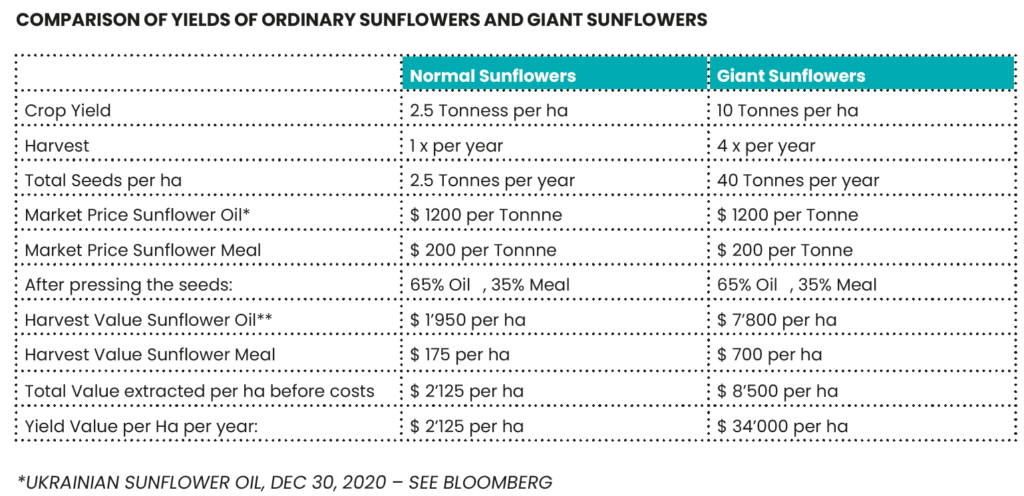Problem Definition: Food Supply
Current mainstream farming methods result in the loss of fertile soil and biodiversity. According to the Food and Agriculture Organization (FAO), the world could run out of topsoil in about 60 years if we continue to destroy the soil at current rates. This affects the planet’s ability to produce food, filter water and absorb carbon. We will not only suffer serious damage to public health due to a qualitatively degraded food supply characterised by diminished nutrition, but we will also literally no longer have enough arable topsoil to feed ourselves.
In addition, our present agricultural system is a major contributor to the emission of greenhouse gases (GHG). In its latest report on climate change, the IPCC states that 24% of the total global GHG emissions are directly related to agricultural production.
Problem Definition: Food Demand
The demand for food is rising exponentially. Looking at the demographics, at present, India and China each have 1.3 billion people, but India has a much stronger population growth than China. By 2025, both countries will each have 1.5 billion people, and India will overtake China as the densest nation on earth. At that point, India and China will represent 40% of the global population, and the demand for commodities of all kinds will keep increasing.
The global population currently stands at 7.8 billion. Estimates put the total population at 8.6 billion by mid-2090 and 9.8 billion by mid-2050.
Another factor in food demand is rising incomes, which lead to an increase in the demand for meat, vegetables, fruits and grains. For instance, in China, 250 million migrants are moving from rural areas to big cities in the Southwest in search of income and work. Everybody needs to eat, have access to drinking water, a roof over their heads and a smartphone. The urban population in China will soon be one billion people.
Additional Demand Problem: Rising Food Prices
The commodity markets tell the story. Since the summer of 2020, the commodity prices of grains have risen by an average of 70%. The prices of containers transporting food around the globe have risen tenfold (such as from CHF 1500 to CHF 15,000 for a container from China to Rotterdam). It will certainly take some time before we see higher prices in the supermarket, but be prepared to pay much more for meat, vegetables and grain products soon.

Monsanto: How not to feed the world
Do you remember the agribiotech conglomerate Monsanto? Monsanto was selling seeds to produce genetically engineered crops. Fifty percent of their turnover was seeds called Roundup Ready, which are resistant to the herbicide glyphosate, a molecule used to kill weeds. Monsanto’s line of products included seeds, such as GMO corn, cotton, soy and vegetable seeds, as well as growth- and milk production-enhancing hormones for pigs and cows.
In 2018, Bayer paid $66 billion to buy Monsanto, a completely incomprehensible and money-losing acquisition. Meanwhile, Monsanto was facing controversy in the United States over claims that its herbicide products might cause cancer. In June 2020, Bayer agreed to settle over a hundred thousand Roundup cancer lawsuits, agreeing to pay $8.8‒$9.6 billion to settle those claims and $1.5 billion for any future claims.
In India, Monsanto was trying to monopolise the cotton seed market by selling genetically modified cotton seeds. Farmers became completely dependent on Monsanto and many could not repay their debts; 300,000 farmers have committed suicide.
The Solution to the Problem: Regenerative Agriculture Regenerative agriculture means the restoration of degraded soil. A thin layer of topsoil is responsible for 95% of all food produced for human consumption.
Regenerative agriculture is a holistic conservation and rehabilitation approach to food and farming systems. It focuses on topsoil regeneration, increasing bio-diversity, improving the water cycle, enhancing ecosystem services, supporting biosequestration, increasing resilience to climate change and strengthening the health and vitality of farm soil. Practices include recycling as much farm waste as possible and adding composted material from sources outside the farm.
Regenerative agriculture sequesters carbon from the atmosphere and has the potential to reverse climate change instead of contributing to it. Without protecting and regenerating the soil on our 4 billion acres of cultivated farmland, 8 billion acres of pastureland and 10 billion acres of forest land, it will be impossible to keep global warming temperature increases below 2°C or halt the loss of biodiversity. Worldwide, 33% of land is moderately to highly degraded (source: Main report of FAO Status of the World’s soil resources, 2015). For example, in Indonesia, 20 million hectares (ha) of burned forests need to be regenerated. By transforming agricultural practices, we can begin to reverse this situation and build healthy and resilient soil.
Enzyme Technology
At Mother Earth Energy, we apply digital and sustainable agriculture and food technologies. Our scientists have developed a proprietary enzyme technology, which can induce the following processes in nature:
Promote the growth of plants and animals.
Our enzyme technology can fertilise the existing agricultural soil to a much higher level, increasing productivity.
1. Giant sunflowers grow without chemical fertilisers or pesticides and are not genetically altered. The sunflowers are four times larger than ordinary sunflowers (see photo) and can generate 40 tonnes of seeds per hectare around the equator. The resulting sunflower oil is a perfect replacement for palm oil.
2. Our enzyme technology promotes growth and weight increases in sheep and pigs. A 40% higher meat production is achieved without any side effects. It prevents and cures swine fever, which is a huge problem in China.
Usage of the following chemicals was totally avoided in the trial subjects:
a) Antibiotics
b) Hormones
c) Chlorine
d) Pesticides
e) Disinfectants

3. Our enzymes can destroy bacteria and cockroaches in drainage systems.
4. Our enzymes can clean wastewater and produce potable water, clearly indicating that the enzymes are able to remove/cleanse some of the worst chemical and biological pollution.
5. Our enzymes can restore and refertilise land that has been destroyed by fires or deforestation. New vegetables and fruits can be planted on a larger scale.
6. Our enzymes can disinfect aerosols, including those containing viruses and germs. This technology can be used in hospitals, retirement homes, schools, industries, etc.
The World Health Organization has classified this enzyme as being in Risk Group 1, meaning that there is no or low individual and community risk, and it is unlikely to cause human or animal disease.
Mother Earth Energy has results from 21 tests carried out by TÜV SüD and SGS. All the test results can be made available to investors and scientists.
Nature Helps Nature!
Roland A. Jansen
Mother Earth Energy
Advocate – EU Tech Chamber























